#1st armoured division
Explore tagged Tumblr posts
Text

Char B1 bis Var n°323 de la 2e Compagnie du 37e Bataillon de chars de combat de la 1ère Division cuirassée abandonné le 14 mai 1940 à Ermeton-sur-Biert – Bataille de Flavion – Bataille de Belgique – Belgique – Mai 1940
Photographe : Heinz Fremke
©Bundesarchiv - Bild 101I-127-0369-21
Lors du redéploiement de la 1ère DCR de Gembloux (bataille de Gembloux) vers Flavion pour arrêter la progression des forces blindées allemandes, le char B1 bis VAR tombe en panne près d'Ermeton-sur-Biert le 14 mai 1940 à hauteur du pont de chemin de fer, à la sortie du village et est abandonné par son équipage. Des soldats allemands ont essayé de le faire repartir, mais sans système de direction, au premier virage venu, le char s'est encastré dans une maison d'Ermeton.
Equipage du char B1 bis VAR perçu par la 2e Compagnie du 37e BCC à Mourmelon le 17 décembre 1939.
Chef de char : Sous-lieutenant de Laromignière
Pilote : Caporal-chef Henouille
Radio : Chasseur Soudain
Aide-pilotes : Caporal Hec et chasseur Sturbeaux
Source : chars-français.net
#WWII#bataille de france#battle of france#bataille de belgique#campagne des 18 jours#battle of belgium#bataille de flavion#battle of flavion#armée française#french army#1ère division cuirassée#1ère DCR#1st armoured division#37e bataillon de chars de combat#37e BCC#char#tanks#char lourd#heavy tank#char B1#char B1 bis#B1 bis#ermeton-sur-biert#belgique#belgium#05/1940#1940
15 notes
·
View notes
Text



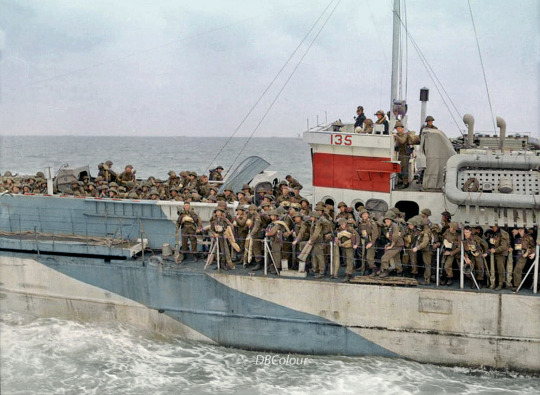
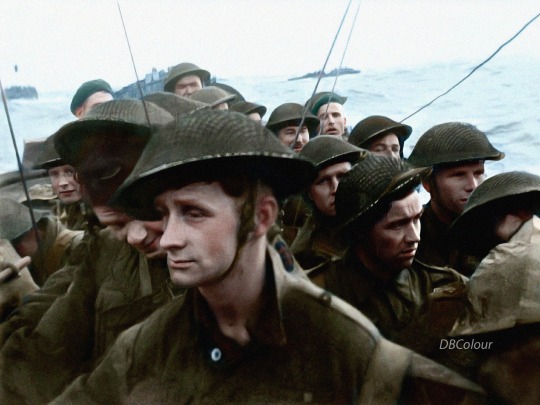





To commemorate the anniversary of D-Day, a short thread of photos colourised by DBColour (Colourising History on Facebook). Descriptions run from top-to-bottom.
Piper Bill Millin, seen here landing on Sword Beach with his bagpipes with Lord Lovat’s Commandos of 1st Special Service Brigade. IWM B 5103.
Commandos of 1st Special Service Brigade after landing on Queen Red beach, Sword area, 6 June 1944. British Airborne troops smile from the door of their Horsa glider as they prepare to fly out as part of the second drop on Normandy on the night of 6th June 1944. LCI(L) 135 of the 2nd Canadian (262nd RN) Flotilla carrying personnel of the North Nova Scotia Highlanders and the Highland Light Infantry of Canada en route to France on D-Day, 6 June 1944. (Library and Archives Canada Photo, MIKAN Nº. 3205043) Film still from the D-Day landings showing commandos aboard a landing craft on their approach to Sword Beach, 6 June 1944.
LCA (Landing Craft Assault) containing soldiers from the Winnipeg Rifles head for the Normandy Juno beach - June 6, 1944.
Commandos approach Sword Beach in a Landing Craft Infantry (LCI). Ahead, the beach is crowded with tanks and vehicles of 27th Armoured Brigade and 79th Armoured Division.
Troops of 3rd Infantry Division on Queen Red beach, Sword area, circa 0845 hrs, 6 June 1944. In the foreground are sappers of 84 Field Company Royal Engineers. Behind them, medical orderlies of 8 Field Ambulance, RAMC, can be seen assisting wounded men.
A Horsa glider near the Caen Canal bridge at Benouville, 8 June 1944. No. 91 (PF800), carried Major John Howard and Lieutenant Den Brotheridge of No.1 Platoon, 'D' Co., 2nd Battalion Oxfordshire and Buckinghamshire Light Infantry in the early hours of D-Day. © IWM B 5232
#d-day#d-day anniversary#ww2#world war 2#second world war#history#military history#british army#lest we forget#remembrance
304 notes
·
View notes
Text
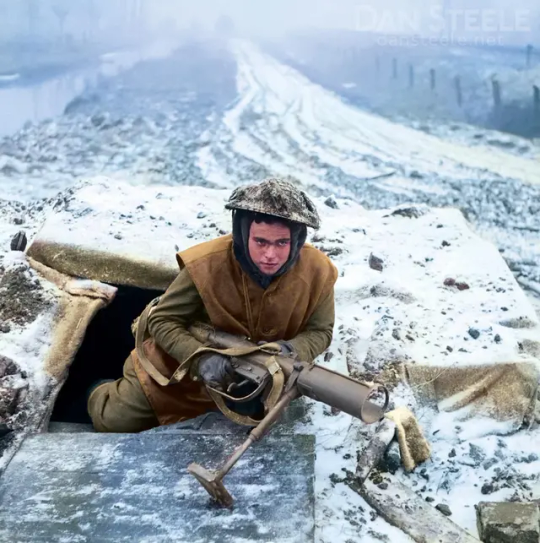
Rfn. Faulkner of London, emerges from his front-line dugout, armed with a PIAT. 1st Battalion Rifle Brigade, 7th Armoured Division, Nieuwstadt, Dutch-German border. 28 Dec 1944.
59 notes
·
View notes
Text

Princess Anne to represent King at events to mark 80th anniversary of Arnhem
12th September 2024 at 4:42pm /// Forces News
Princess Anne will travel to Oosterbeek in the Netherlands to commemorate the 80th anniversary of Operation Market Garden – one of the Second World War's most famous battles.
The Princess Royal will be representing the King at events during the two-day visit accompanied by her husband Vice Admiral Sir Tim Laurence.
In 1944, the Allies came up with an ambitious plan – codenamed Market Garden – to cross the River Rhine, advance deep into northern Germany and shorten the war.
It involved the seizure of key bridges in the Netherlands by the 101st and 82nd US Airborne Divisions and the 1st British Airborne Division, supported by Polish airborne forces, which would land by parachute and glider.
If successful, the plan would free the Netherlands, look to outflank Germany's frontier defences, the Siegfried Line, and make possible an armoured drive into Germany's industrial heartland.
It unfortunately failed to achieve its objectives, with 30 Corps unable to reach the furthest bridge at Arnhem before German forces overwhelmed the British defenders, but the bravery shown by the airborne troops is honoured annually.
The failure of Market Garden ended Allied expectations of finishing the war by Christmas 1944 – it would not end until 2 September 1945.

Operation Market Garden was an unsuccessful Allied military operation that took place in the Netherlands in September 1944 (Picture: Alamy)
Princess Anne and Vice Admiral Laurence will attend commemorations at the Airborne Museum Hartenstein accompanied by Colonel Commandant of The Parachute Regiment, Major General Oliver Kingsbury.
In September 1944, it was where Major-General Roy Urquhart, the commander of 1st Airborne Division, set up his headquarters.
At the Airborne Museum, Princess Anne is set to tour the building, viewing displays on remembrance, occupation and commemoration.
She will later present four honorary MBEs then, following the presentation, the Princess Royal and Vice Admiral Laurence will watch the Red Devils carry out a parachute display before meeting veterans, local dignitaries, military representatives, and volunteers.
After the display, Princess Anne will make a speech to mark the anniversary of Operation Market Garden, acknowledging the bravery and sacrifice of British, Dutch and Allied Troops.

The King (then Prince of Wales) laid the first wreath at a Polish Memorial and paid tribute to the bravery of Polish paratroopers during Operation Market Garden in 2019 (Picture: MOD)
On Sunday 22 September, Princess Royal, as President of the Commonwealth War Graves Commission (CWGC), will attend the annual service to commemorate the 80th Anniversary of Operation Market Garden.
At the start of the service, the party will process into the cemetery towards the Cross of Sacrifice where there will be approximately 1,000 guests gathered ahead of the service.
Princess Anne will then read a lesson and, at the conclusion, lay a wreath at the foot of the Cross of Sacrifice.
There will be a flypast by the Historical Flight of the Royal Netherlands Airforce and the Battle of Britain Memorial Flight.
After the service, Princess Royal will pay a private visit to the home of the daughter of The Angel of Arnhem, Kate ter Horst, who bravely tended to hundreds of injured British soldiers during the battle.
#glad that tim is going with her 🥰#princess anne#princess royal#tim laurence#timothy laurence#news#netherlAnneds
26 notes
·
View notes
Photo

Dunkirk Evacuation
The Dunkirk Evacuation of 26 May to 4 June 1940, known as Operation Dynamo, was the attempt to save the British Expeditionary Force in France from total defeat by an advancing German army. Nearly 1,000 naval and civilian craft of all kinds, aided by calm weather and RAF air support, managed to evacuate around 340,000 British, French, and Allied soldiers.
The evacuation led to soured Franco-Anglo relations as the French considered Dunkirk a betrayal, but the alternative was very likely the capture of the entire British Expeditionary Force on the Continent. France surrendered shortly after Dunkirk, but the withdrawal allowed Britain and its empire to harbour its resources and fight on alone in what would become an ever-expanding theatre of war.
Germany's Blitzkrieg
At the outbreak of the Second World War when Germany invaded Poland on 1 September 1939, France was relying almost entirely on a single defensive line to protect itself against invasion. These defences were the Maginot Line, a series of mightily impressive concrete structures, bunkers, and underground tunnels which ran along France's eastern frontiers. Manned by 400,000 soldiers, the defence system was named after the French minister of war André Maginot. The French imagined a German attack was most likely to come in two places: the Metz and Lauter regions. As it turned out, Germany attacked France through the Ardennes and Sedan on the Belgian border, circumventing most of the Maginot Line and overrunning the inadequate French defences around the River Meuse, inadequate because the French had considered the terrain in this forested area unsuitable for tanks. Later in the campaign, the Maginot Line was breached near Colmar and Saarbrücken.
To bolster the defences of France, Britain had sent across the British Expeditionary Force (BEF) under the command of General John Vereker (better known by his later title Lord Gort, 1886-1946). Around 150,000 men, mostly infantry, had arrived in September 1939 to strengthen the Franco-Belgian border. The BEF included the British Advanced Air Striking Force of 12 RAF squadrons. The aircraft were mostly Hawker Hurricane fighters and a few light bombers, all given much to the regret of RAF commanders who would have preferred to have kept these planes for home defence. The superior Supermarine Spitfire fighters were kept safely in Britain until the very last stages of the battle in France. The BEF had no armoured divisions and so was very much a defensive force, rather than an offensive one. More infantry divisions arrived up to April 1940, so the BEF grew to almost 400,000 men, but 150,000 of these had little or no military training. As General Bernard Montgomery (1887-1976) noted, the BEF was "totally unfit to fight a first class war on the Continent" (Dear, 130). In this respect, both Britain and France were very much stuck in the defensive-thinking mode that had won them the First World War (1914-18). Their enemy was exactly the opposite and had planned meticulously for what it called Fall Gelb (Operation Yellow), the German offensive in the west.
Totally unprepared for a war of movement, the defensive-thinking French were overwhelmed in the middle weeks of May 1940 by the German Blitzkrieg ("lightning war") tactics of fast-moving tanks supported by specialist bombers and smartly followed by the infantry. German forces swept through the three neutral countries of the Netherlands, Luxembourg, and Belgium. The 9th Army punched through the Ardennes and raced in a giant curve through northeast France to reach the coast around Boulogne. The BEF and the northern French armies (7th and 1st) were cut off from the rest of the French forces to the south. Germany had achieved what it called the 'Sickle Slice' (Sichelschnitt). By 24 May, the French and British troops were isolated and with their backs to the English Channel, occupying territory from Dunkirk to Lille. Although there were sporadic counterpunches by the defenders, Gort had already concluded that the French army had collapsed as an operational force. Gort considered an attack on the Germans to the south, which he was ordered to make, would have achieved very little except the annihilation of his army. The BEF must be saved, and so he withdrew to the north.
Continue reading...
28 notes
·
View notes
Text
COMPILING...
...
...
Right, it's been a bit, but I finally got that report declassified for everyone, no sense hiding the shame if we want to maintain a semblance of reputation.
The New Albion conflict.
Location: Streppon City/Orbital Evevator "The Beanstalk"/Sector 11 Polar missile base, New Albion, Diaspora World
Time: 22.06.5025u-04.11.5025u
Result: Close Victory against Rogue Mercenary Warband "Hand of Roland", total planetary nuclear disarmament.
Territorial Changes: At time of writing negotiations are undergoing to see if New Albion will remain Diaspora or be absorbed into Union.
Belligerents: New Albion Resistance/DoJ/HR Peacekeeper Battlegroup 7 (Unknown division)/Albatross Wing (Unkown battlegroup)/ACS Internal Affairs Mechanised Battlegroup 4, 13th Shock Division/"Atom Walkers" Mercenary Battlegroup, Disaster Branch 6 and Rogue Mercenary Warband "Hand of Roland" Battlegroup 1, 23rd Armoured Division, 11th Strike Division, Battlegroup 5, 8th Naval Division, 2nd Artillery Division and Battlegroup 8, 32nd Infantry Division, 1st Exotic Materials Division, 15th Strike Division.
Commander's and Leaders: Douglas Hopp (NAR), Harriet Vern (NAR), Unkown Union DoJ/HR Commander, Unkown Albatross Commander, Lucriza Diaz (IA), Marchionne Torrens (IA), Hui Ci Ardito (AW), Voinea Mcbrown (AW), Creche Hindman (AW), Simson Birkenholz (HoR), Prasanta Vanguilder (HoR), Prasanta Vanguilder (HoR), Irmengild Belizaire (HoR), Razvan Maloof (HoR), Delphin Busscher (HoR), Erblina Paro (HoR)
Casualties: NAR: 155,000 (23,505 Captured or MIA), DoJ/HR: 10,230 (332 MIA), Albatross: 11,600 (12 MIA), ACS IA 16,070 (844 Captured or MIA), AW 55,700 (7 MIA), HoR 450,000 (10,645 Captured by NAR, 10,312 Captured by DoJ/HR 41,602 Captured by ACS IA, 6,453 MIA).
Further Notes: Questioning has been slow going, as expected most of the HoR grunts were kept in the dark as to why they were attacking, explanations varied, ranging from official ACS endorsement (we didn't), guidance from a "Higher Power" or A wealthy anonymous Contracter (who can pay a mercenary company to steal a planet?) To mame a few excuses. On a more positive note, relief work has gone well thanks to support from @officialunionhr and @albatross-lancer so New Albion is looking to be rebuilt by the end of the planetary year. Lucriza has filed numerous questions to the requisition teams to try and find out when the HoR went rogue.
That is all, Tallow Out.
#lancer rpg#avolio combat solutions#lancer#lancer rp#lancer ttrpg#oc rp#acs lancer#lancerrpg#lancer acs#new albion#lancer albatross#union doj/hr
11 notes
·
View notes
Text

Christmas at the frontlines in Groesbeek 1944
The Netherlands
Picture: PIAT gunner of 1st Battalion Rifle Brigade British 7th Armoured Division, December 1944.
8 notes
·
View notes
Text

Of the corps commanders, I remember nothing, except perhaps Grand Duke Pavel Alexandrovich, uncle of the Emperor, who received this great assignment whilst still a very young man, almost immediately after his command of the Life Guards Cavalry Regiment. During his journey along the forward line of the Main Camp in Krasnoe Selo (the 1st and 2nd Guards Infantry Divisions) the Grand Duke once did not meet the assistant on duty for the regiment at the proper place, namely at the camp guard's banner, at the location of the Egersky Life Guards Regiment's camp. The officer concerned had been obliged to be continually at this place, being stationed in the 'duty tent', in case of the appearance of a superior, to report to him about the welfare of the regiment. As a result, the officer who was absent so inopportunely, received a comment in the regimental order. It was I. The most august corps commander had decided to drive up to the regiment when I, having been overcome by a call of duty, had decided to leave for five minutes in some need!
Grand Duke Pavel was famous for his tall and slim Romanov figure, beauty and elegance. Many cornets envied his stylish high boots which were so well set off by the long, thin legs. When the Grand Duke dismounted, he lovingly patted the hard tops of his English boots with his riding crop with its expensive handle.
An excellent representation of him is the famous portrait by Serov, where the Grand Duke and his black horse are painted from the knee up, both restive heads close together. The artist has skilfully captured the military elegance of Pavel Alexandrovich in his white tunic, gilded armour and helmet of the Life Guards Cavalry Regiment.
The second marriage of the widowed Grand Duke in defiance of the Tsar's prohibition knocked him out of the smooth service track which was due to him by his status. It was much later, during the war of 1914-17, that we saw him again as a commander of a Guards corps, in the same position over seventeen or eighteen years.
In the summer of 1916, I presented the Life Guards Izmailovsky Regiment to him. Grey-haired, not without old-age wrinkles, the Grand Duke, had a new beauty, he still shone with military style and harmony of figure; but he didn't slap the riding crop against the top of his amazing boots; it was the century of the motor car, and there was no need for a crop.
Pavel Alexandrovich's elder brother, Grand Duke Vladimir, in the 1890s commanded all the troops in the St Petersburg military district. He wasn't as tall as 'brother Pavel' as he called him, but no less handsome and thoroughbred.
To Serve the Russian Empire: The Autobiography of Boris Héroys - John Elverson
#imperial russia#russian imperial family#romanov#paul alexandrovich#vladimir alexandrovich#grand duke#russian imperial army
11 notes
·
View notes
Text
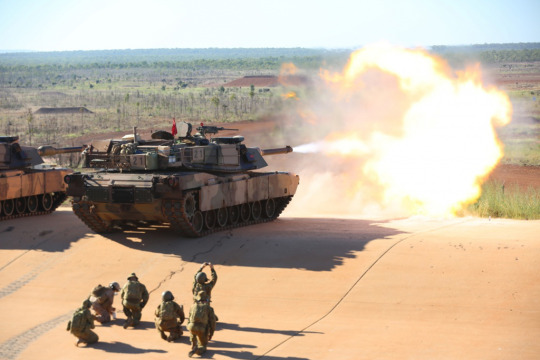
U.S. Marines test-fire tanks after barrel replacement while training in Australia MOUNT BUNDEY TRAINING AREA, Australia (May 6, 2017) - U.S. Marine Lance Cpl. Fernando Griego, gunner, Company K, 3rd Battalion, 4th Marine Regiment, 1st Marine Division, Marine Rotational Force Darwin, remotely fires an M1A1 Abrams with B Squadron 1st Armoured Regiment of the Royal Australian Armoured Corps. Marines remotely test fired the Abrams as a precaution after Australian Army soldiers had replaced the barrel ensuring its mission readiness. (U.S. Marine Corps photo by Lance Cpl. Damion Hatch Jr) 170506-M-QL150-163
15 notes
·
View notes
Text
Here's something I've been working on in the last few days (and will stay as a work-in-progress forever, most likely):

I had an idea of how Tails could have looked like if the Phantom Ruby had corrupted him and he had been the antagonist in Sonic Forces instead of Infinite.

More details will be left under the "Read more" cut.
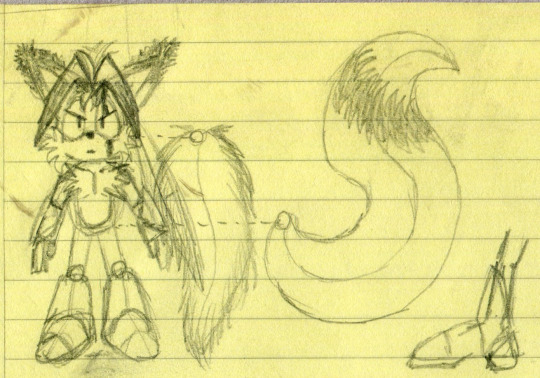
The 1st reference sheet is for Tails without most parts of an armour I had come up with. He still has a couple of plates on the outer side of each forearm and the front side of each leg, as well as the boots, which are technically part of the armour too. Separated from the main model for his body are a ponytail and each of his tails (no, he's not supposed to have only one tail here).
Yes, I gave him Zero's long, long ponytail from Mega Man X, as well as Sephiroth's hair bangs, an "edgelord scar" over his left eye, and the chunky armoured legs you'd usually find in Mega Man characters. His boots have some slightly "platformy" heels. He also gets ridiculously long and fluffy tails.
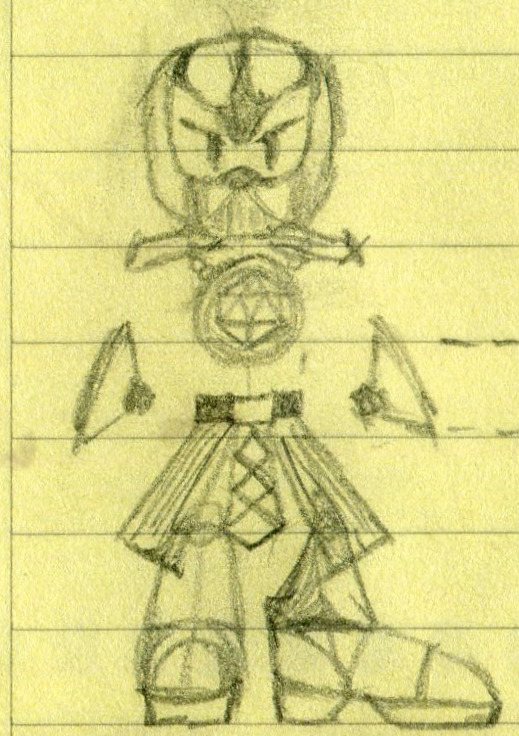
The 2nd reference sheet is for pieces of his armour, including a mask. The plate on the outer side of the left forearm is also a support for a shield.
That thing in his chest would be the Phantom Ruby. Instead of being embedded in his chest like it was in Infinite, it'd be on a sort of necklace; this necklace would be inspired by the sprite of Dark Matter Swordsman featured in Kirby: Mass Attack.

Also, a few ideas for the shield:
It's circular with a four-pointed star, like Galacta Knight's shield. Each quarter would have the name (they're written in Chinese, Korean & Hindi here and I was thinking about writing them in Japanese kanji as well because I'm kind of a massive weeb but I don't wanna admit it) of one of the 4 Horsemen of the Apocalypse.
If Tails turns good again but keeps this attire and some Phantom Ruby powers, the shield would have an eight-pointed star instead. Each of the 8 divisions would have the name of each of the 8 factors of the Noble Eightfold Path (the path to Nirvāṇa).
And here's an attempt at drawing something other than reference sheets and playing a bit with perspective and poses:

Along with a shield, he gets a comically large weapon (a one-of-a-kind polearm that's actually a mix of various types of them). He also wears a cloak here, inspired by both Dark Matter Swordsman and Drawcia Sorceress from Kirby: Canvas Curse; I was thinking about giving him some sort of stole, tippet or ceremonial scarf as well, like the one worn by Raven Beak in Metroid Dread. He's supposed to be contemplating his weapon, and I tried to draw him with a sad face (or rather, a sad look, since most of his face is hidden under the mask). And for that polearm carried by Tails here, I took elements from the halberd, the poleaxe, the voulge or couteau-de-brèche, the spontoon and the partisan.
Someone else thought this pose was inspired by an iconic scene involving Sephiroth, but that was purely a coincidence (though I can't blame them for thinking otherwise). The pose was inspired by something entirely different, which is the following piece of Galacta Knight fanart (of course...) by @pastelaeqy: https://www.tumblr.com/pastelaeqy/712750532813520896

Here are a few drawings of comically large weapons for Tails (namely, a chokutō or "straight sabre", the aforementioned "polearm fusion", and an ōdachi or "long sabre") compared with the 1st reference sheet and also a glimpse of the shield for a "redeemed" Tails:

And this is it for now. I'll try to come up with something else later, such as a summary of a story where these ideas could be used.
#sonic#sonic the hedgehog#tails#tails the fox#miles tails prower#sonic forces#what if#infinite the jackal#mega man#megaman#rockman#mega man x#megaman x#rockman x#zero#zero megaman#sephiroth#final fantasy#final fantasy 7#final fantasy vii#ff7#ffvii#kirby#kirby of the stars#hoshi no kirby#galacta knight#dark matter blade#dark matter swordsman#drawcia#kirby mass attack
16 notes
·
View notes
Text
A Short Timeline of the Events of 422-3
(Somewhat of a companion piece to Wei-Song Wars Part 1)
guihai day of the fifth month (June 26th 422): Liu Yu dies. Liu Yifu, aged 16, inherits the throne.
An unknown time between the fifth month and ninth month: Tuoba Si heard of Liu Yu's death and plans an invasion of Liu-Song.
At some point before troops are sent out: After a long debate, although Tuoba Si agreed with Cui Hao that the countryside should be attacked first, on the insistence of Gongsun Biao and Daxi Jin he uses the strategy of attacking the three cities first.
Ninth month: Daxi Jin, Gongsun Biao and the others lead 20,000 troops to attack Huatai, but are unable to take it.
dingchou day of the tenth month (November 7th): Northern Wei launches an attack on Chenliu, and the governor Yan Leng surrenders.
renchen day of the tenth month (November 22nd): Daxi Jin and the others ask for reinforcements. Tuoba Si, angry, rebukes Daxi Jin and Gongsun Biao for insisting on attacking cities and gathers 50,000 troops from his vassals, which he leads to aid them as reserve troops.
Eleventh month: Tuoba Dao is sent to guard against Rouran, leaving the minister An Tong and another son of Tuoba Si's, Tuoba Mi, to guard the capital.
gengxu day of the eleventh month (December 10th): Northern Wei forces take Huatai. Wang Jingdu flees, while Ruogan Er is appointed to guard the city.
Shortly after: Daxi Jin and the others take Tulou garrison, and move to threaten Hulao, while Wuniuyu Lidi leads 3,000 to threaten Luoyang.
bingxu day of the twelfth month: Tuoba Si sends Yizhan Jian with a force to attack Qing and Yan provinces.
Twelfth month: Wuniuyu Lidi and Daxi Jin attack Dou Huang together and defeat him. Tuoba Si sends E Qing, Yujiulu Dafei and Pu Ji to take Que'ao.
guiwei day of the twelfth month (January 12th of 423): The Song governor of Yan province, Xu Yan, abandons the province, allowing Yizhan Jian to enter Qing provinces.
wuzi day of the twelfth month (January 17th): Northern Wei threatens Hulao.
jichou day of the twelfth month (January 18th): Liu Yifu sends Tan Daoji to relieve the threatened provinces.
guimao day of the first month of the first year of Jingping (February 1st): Wuniuyu Lidi takes Jinyong fortress and takes him; Tuoba Si appoints him to remained stationed.
First month: Yizhan Jian enters Qing provinces, taking many of the surrounding cities, but Zhu Kui orders that Dongyang be bolstered as a defense center and outside grain be burned.
Third month: Daxi Jin and the others assault Hulao with 15,000 troopsl. Mao Dezu digs tunnels to burn Northern Wei siege equipment; but despite killing hundreds of troops, the Northern Wei army quickly resume their siege.
Tuoba Si sends troops from Ye to help attack Hulao. Daxi Jin leads 3,000 troops out of Hulao, while leaving Gongsun Biao and the rest of the troops to attack Xuchang, and Li Yuande flees. He seizes Henan commandery, Yingchuan commandery and Chen commandery before returning to Hulao.
Gongsun Biao fought a fierce battle at Hulao, and at first Mao Dezu killed hundreds of Wei troops. But when Daxi Jin returned from seizing nearby land, he attacked Mao Dezu and defeated him; Mao Dezu lost more than a thousand armoured men, and he stopped venturing out of Hulao, keeping resistance from inside the city.
Tuoba Si sent 10,000 troops to cross the Yellow River to camp at Puyang and strengthen his hold on Yan province.
Mao Dezu frames Gongsun Biao as a collaborator; Daxi Jin falls for the trap and tells Tuoba Si. Eventually, a petition is sent blaming Gongsun Biao for the length of the siege. As well, Tuoba Si was frustrated with Gongsun Biao's military mistakes, so due to all of this, he sent someone to kill Gongsun Biao, but since he did not announce Gongsun Biao's death, Mao Dezu's ploy failed to cause division in the Wei army.
Tan Daoji, seeing that he was closer to Qing province and they were in more need of aid, saves Qing province, essentially abandoning Si province due to his lack of troops.
Third month: Tuoba Si sends 50,000 cavalry to relieve Yizhan Jian; when the Wei army attacked Qing province, in total 60,000 Wei cavalry crossed the Yellow River from beginning to end (the Zizhi Tongjian's placement of Tuoba Si's sending of Diao Yong must be incorrect; it was in the late second or early third month, not in the first month)
jiazi day of the third month (April 23rd): Li Yuande launches a surprise attack on Xuchang and recaptures it (The Weishu dates this to the ninth month instead).
E Qing, Pu Ji and Yujiulu Dafei seize the rest of Yan province, reaching Gaoping and Hulu, where, after the civilians shoot at them with arrows, they massacre the men of more than two thousand families and take as captives the women and children.
Tuoba Si sends the governor of Bing province, Yilou Ba, to help assault Hulao. While Mao Dezu killed many Wei troops, he was losing many of his own soldiers as well.
dingmao day of the fourth month (April 26th): Tuoba Si leads a reinforcement army into Hulao. After cutting off water from the Yellow River to Hulao, he waited for three days before personally supervising an assault. However, the city still did not submit, so he left Hulao for Luoyang.
jisi day of the fourth month (April 28th): Tan Daoji arrives at Linzi.
renshen day of the fourth month (May 1st): Since Tan Daoji arrived and a plague had spread through the army at Qing province, Yizhan Jian burns his siege equipment and retreats.
Tan Daoji camps his troops at Hulu, and Wang Zhongde soon joins him. Diao Yong gathers refugee families at Yinmao. Yizhan Jian joins the fight at Hulao, but this also spreads the plague his troops encountered to the troops at Hulao.
dingsi day of the intercalary month (June 15th): Northern Wei blocks access to Hulao's wells.
jiwei day of the intercalary month (June 17th): Hulao falls. Mao Dezu and his officers are almost all captured.
Fifth month: Tuoba Si returns to Pingcheng.
Ninth month: Tuoba Si calls Daxi Jin back from Hulao, leaving troops to guard the south.
Eleventh month: Pu Ji attacks Xuchang, which falls.
wuchen day of the eleventh month (December 23rd): Northern Wei takes Ruyang commandery. Pu Ji destroys Xuchang's walls and Zhongcheng city before returning to garrison Fangtou.
jisi day of the eleventh month (December 24th): Tuoba Si dies.
3 notes
·
View notes
Text
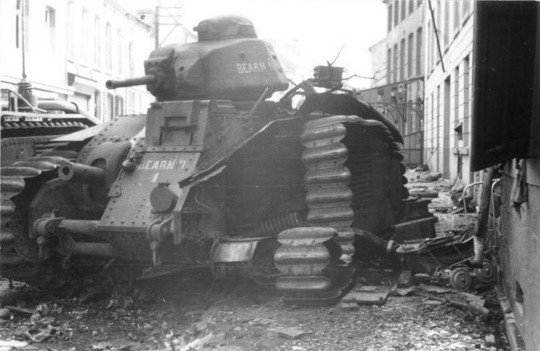
Char B1 Bis Bearn II 401 du 37e Bataillon de Chars de Combat de la 1ère Division cuirassée saboté par son propre équipage par manque de carburant - Bataille de Flavion – Bataille de Belgique – Beaumont – Belgique – Mai 1940
Photographe : Heinz Fremke
©Bundesarchiv - Bild 101I-125-0277-09
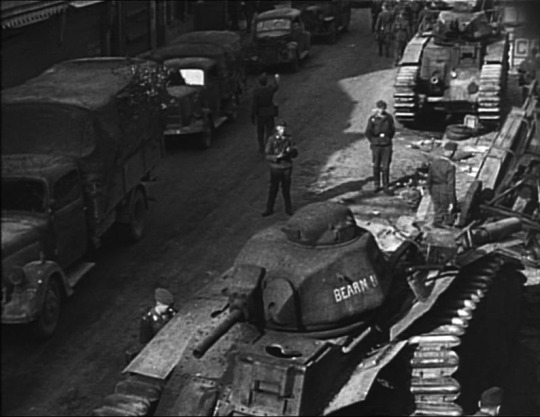
Après la bataille de Flavion opposant les unités blindées françaises et allemandes dans le secteur de Charleroi en Belgique le 15 mai 1940, la 1ère Division cuirassée est contrainte au repli sur Beaumont. Le lendemain, 16 mai, la division tente de défendre Beaumont avant de céder le terrain. La dernière compagnie du 37e Bataillon de chars de combat à court de carburant, les équipages n'ont pas d'autre choix que de saborder leurs B1 bis avant la retraite. Le char B1 bis BEARN II 401, char du chef de bataillon, le Commandant Jean-Marie Courtot de Cissey, est sabordé rue Madame. A ses côtés, le MEUSE sera déplacé par les Allemands pour libérer le passage.
Equipage du char B1 bis BEARN II 401
Chef de char : Commandant Jean-Marie Courtot de Cissey
Pilote : Sergent Bonnat
Radios : Adjudant René Morlot et sergent Hubert Chabod
Aide-pilotes : Caporal René Lequeux et chasseur Bischoff
#WWII#Bataille de france#battle of france#bataille de belgique#battle of belgium#campagne des 18 jours#bataille de flavion#battle of flavion#armée française#french army#1ère division cuirassée#1st armoured division#1ère dcr#37e bataillon de chars de combat#37e bcc#char#tanks#char lourd#heavy tank#b1 bis#beaumont#belgique#belgium#05/1940#1940
13 notes
·
View notes
Text
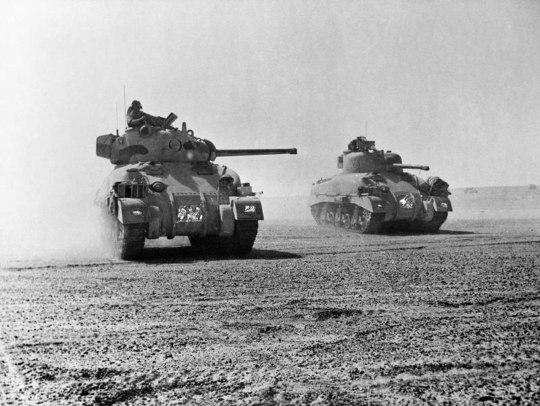
Sherman IIs of 'C' Squadron, 9th Queen's Royal Lancers, 2nd Armoured Brigade, 1st Armoured Division, Eighth Army, during the Second Battle of El Alamein, November 5th, 1942.
The Sherman II was the designation for the M4A1 Medium Tank in British service. The tank was supplied to the UK via the lend-lease program by the United States, and the Second Battle of El Alamein was the first the Sherman ever saw combat in World War II. It would not be the last, as the M4 "Sherman" Medium Tank would see combat throughout the rest of the war with a multitude of upgrades, and see action in every theater of war, from the jungles of Pacific islands, to the bitter cold of Eastern Europe.
9 notes
·
View notes
Text

Albert Speer inspecting the captured M4A1 "War Daddy II" at Kummersdorf.
This tank was captured in Africa by the Germans and brought back to the famous testing site Kummersdorf. The tank was originally built by Lima Locomotive Works in July 1942 and was one out of 134 M4A1 Shermans built there. The tank was later used by the 3rd Battalion of the 1st Armoured Regiment of the 1st Armoured Division. The 1st Armoured Division used different bars and dots to designate the units in the division. War Daddy II was part of Company G. The rough translation of the German writing on the side states: Do not deconstruct! Designated for the High Command of the Army (O.K.H.) Captured by the 1st Company of Heavy Tank Battalion 501st.
16 notes
·
View notes
Text
Chilean Army 1st Cav Regt (Grenadiers)
Part of my Ukrainian War Universe
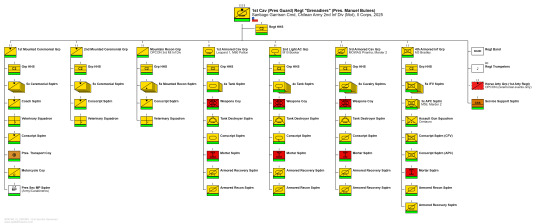
IMU the tensions in Peru and the ongoing armed forces modernization in Argentina under Millei, as well as Bolivian threats to the north and a growing pivot to BRICS, would lead to a renewed expansion of the Chilean Armed Forces planned under the final months of the late Sebastian Pinera presidency and now starting to bear fruit under Gabriel Boric who was the only leftist leader in South America to speak out in support of Ukraine to counteract all these especially given the leftist attitudes in Peru against the rightist presidency of the past years especially in the country's south.
IRL it is a one squadron/battalion (termed Group) regiment that maintains traditions of the Chilean Army cavalry and its a mainly mounted formation that for nearly two centuries, off an on, has provided the mounted travelling escort to the presidency and in wartime is operationally controlled by the 3rd Mountain Division. It also provides guards of honor for state visits. It reports as part of the Santiago Garrison Command alongside the 1st MP Regiment.
IMU such a commitment would allow thus the regiment to have a mixed role as both presidential guard and as a combat formation with two out of its 8 squadrons - the seventh being the training squadron OPCON under the Equestrian School in Quilotta's Camp San Isidro and the 8th being the dismounted honors squadron that provides dismounted public duties in the capital - being mounted ceremonial cavalry and the 3rd being mountain recon that in wartime is a part of the 3rd Division alongside the other two. All of the groups have a conscript company in keeping with the Chilean practice of conscription in the armed forces (the 4th armored group has two). The three mounted groups also have a veternary unit.
The Honors Group also hosts the Cuadro Negro exhibition team - a formation IMU mixed with personnel of the 3rd Cavalry Regiment in the 4th Division, since it is where it had been originated.
The 1st Group also hosts a vehicle company, motorbike company to provide force multipliers to the Carabineros in presidential events and a coach squadron which takes care of the presidential horse drawn coaches and the presidential cars.
Unlike the lancers IRL, each of the ceremonial mounted squadrons are organized as lancers and dragoons/mounted rifles to mirror the historical Chilean cavalry of years goneby. The mounted recon squadons of 3rd Group are trained as combat soldiers only - while the 2 other groups are trained in both combat operations and ceremonial roles, alongside the Horse Artillery Group of the Tacna Regiment - IMU a regimental OPCON unit in ceremonial events only due to its use of horses.
The regiment's other combat capabilities are 4 armoured groups - 2 armored and 1 cavalry and mechanized infantry each in support of elements of the 2nd Infantry Division (Mot) and the Santiago Garrison Command. The 1st Armored Group, which uses MBTs, operates M60s and Leopard 1s, the 2nd is a light formation armed with M10 Bookers, the 3rd is an armored cav unit with Marder 2s and the nationally produced MOWAG Piranhas via FAMAE which performs recon and light attack roles and the 4th is the largest of the groups performing mechanized infantry roles in a mix of IFVs and APCs in support of the cavalry and armor, with the M3 Bradley, M59s, Marder 2s and the Centauros in assault gun role also to provide support to the combat elements of the 2nd Division's two BCTs.
@lukeexplorer
3 notes
·
View notes
Photo
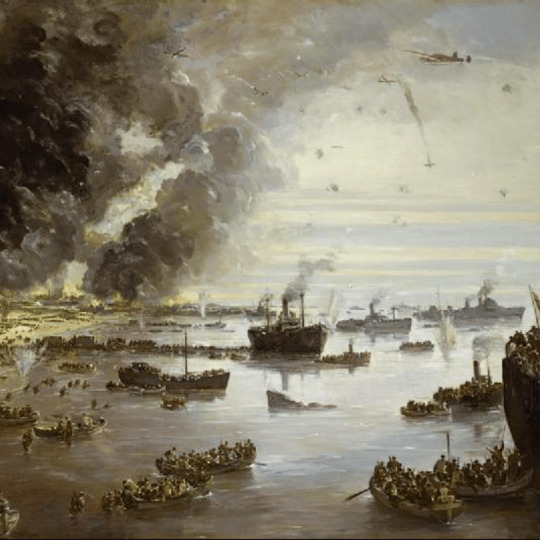
Dunkirk Evacuation
The Dunkirk Evacuation of 26 May to 4 June 1940, known as Operation Dynamo, was the attempt to save the British Expeditionary Force in France from total defeat by an advancing German army. Nearly 1,000 naval and civilian craft of all kinds, aided by calm weather and RAF air support, managed to evacuate around 340,000 British, French, and Allied soldiers.
The evacuation led to soured Franco-Anglo relations as the French considered Dunkirk a betrayal, but the alternative was very likely the capture of the entire British Expeditionary Force on the Continent. France surrendered shortly after Dunkirk, but the withdrawal allowed Britain and its empire to harbour its resources and fight on alone in what would become an ever-expanding theatre of war.
Germany's Blitzkrieg
At the outbreak of the Second World War when Germany invaded Poland on 1 September 1939, France was relying almost entirely on a single defensive line to protect itself against invasion. These defences were the Maginot Line, a series of mightily impressive concrete structures, bunkers, and underground tunnels which ran along France's eastern frontiers. Manned by 400,000 soldiers, the defence system was named after the French minister of war André Maginot. The French imagined a German attack was most likely to come in two places: the Metz and Lauter regions. As it turned out, Germany attacked France through the Ardennes and Sedan on the Belgian border, circumventing most of the Maginot Line and overrunning the inadequate French defences around the River Meuse, inadequate because the French had considered the terrain in this forested area unsuitable for tanks. Later in the campaign, the Maginot Line was breached near Colmar and Saabrücken.
To bolster the defences of France, Britain had sent across the British Expeditionary Force (BEF) under the command of General John Vereker (better known by his later title Lord Gort, 1886-1946). Around 150,000 men, mostly infantry, had arrived in September 1939 to strengthen the Franco-Belgian border. The BEF included the British Advanced Air Striking Force of 12 RAF squadrons. The aircraft were mostly Hawker Hurricane fighters and a few light bombers, all given much to the regret of RAF commanders who would have preferred to have kept these planes for home defence. The superior Supermarine Spitfire fighters were kept safely in Britain until the very last stages of the battle in France. The BEF had no armoured divisions and so was very much a defensive force, rather than an offensive one. More infantry divisions arrived up to April 1940, so the BEF grew to almost 400,000 men, but 150,000 of these had little or no military training. As General Bernard Montgomery (1887-1976) noted, the BEF was "totally unfit to fight a first class war on the Continent" (Dear, 130). In this respect, both Britain and France were very much stuck in the defensive-thinking mode that had won them the First World War (1914-18). Their enemy was exactly the opposite and had planned meticulously for what it called Fall Gelb (Operation Yellow), the German offensive in the west.
Totally unprepared for a war of movement, the defensive-thinking French were overwhelmed in the middle weeks of May 1940 by the German Blitzkrieg ("lightning war") tactics of fast-moving tanks supported by specialist bombers and smartly followed by the infantry. German forces swept through the three neutral countries of the Netherlands, Luxembourg, and Belgium. The 9th Army punched through the Ardennes and raced in a giant curve through northeast France to reach the coast around Boulogne. The BEF and the northern French armies (7th and 1st) were cut off from the rest of the French forces to the south. Germany had achieved what it called the 'Sickle Slice' (Sichelschnitt). By 24 May, the French and British troops were isolated and with their backs to the English Channel, occupying territory from Dunkirk to Lille. Although there were sporadic counterpunches by the defenders, Gort had already concluded that the French army had collapsed as an operational force. Gort considered an attack on the Germans to the south, which he was ordered to make, would have achieved very little except the annihilation of his army. The BEF must be saved, and so he withdrew to the north.
Continue reading...
34 notes
·
View notes